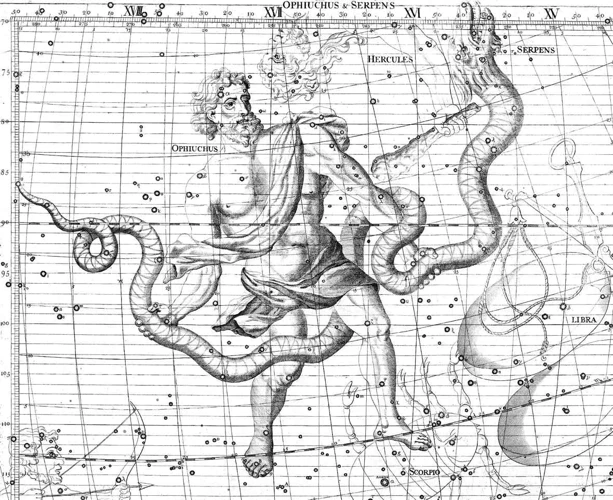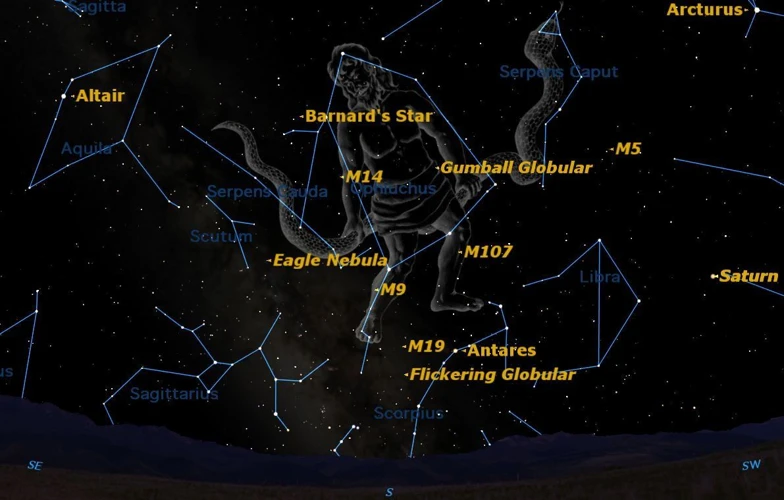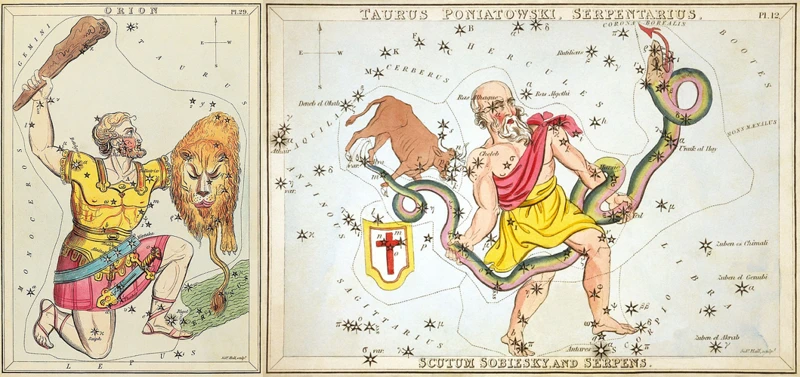Have you ever heard of Ophiuchus? This celestial figure is often overlooked in Western astrology, as it is not one of the traditional twelve zodiac signs. However, Ophiuchus holds great significance in various mythologies around the world. From Ancient Egypt to Greece, China, Mesoamerica, and Native American cultures, Ophiuchus is associated with healing, serpents, and the balance between life and death. Join us as we delve into the captivating and diverse cultural interpretations of Ophiuchus, shedding light on its mystical role in different mythological traditions.
Ancient Egyptian Mythology

In Ancient Egyptian mythology, Ophiuchus played a significant role, intertwining with the culture’s beliefs in healing and astrology. Ophiuchus was identified with Imhotep, the God of Healing and Medicine. Imhotep was revered as a genius physician and architect, credited with creating various medical advancements and even designing the iconic Step Pyramid of Djoser. The association of Ophiuchus with Imhotep highlights the profound significance of this constellation in Egyptian culture. Ophiuchus holds a place in Egyptian astrology, despite not being included in the traditional twelve zodiac signs. Individuals born under the influence of Ophiuchus are believed to possess healing powers and a deep connection with spirituality. To learn more about Ophiuchus in astrology and debunk common misconceptions, check out our dedicated article “Ophiuchus Astrology: Facts and Misconceptions.”
Ophiuchus as Imhotep, the God of Healing
In Ancient Egyptian mythology, Ophiuchus takes on the persona of Imhotep, the God of Healing. Imhotep was a revered figure in Egyptian culture, known for his immense wisdom and healing abilities. He was not only considered a deity but was also a historical figure who served as the vizier to Pharaoh Djoser during the Third Dynasty. Imhotep’s association with Ophiuchus highlights the constellation’s connection to healing and medicine within Egyptian beliefs. Imhotep was considered the ultimate healer, and his teachings and practices influenced Egyptian medicine for centuries. He was often depicted with a serpent intertwined around a staff, symbolizing his connection to Ophiuchus and its significance as a healing constellation. The serpent motif, representing rebirth and regeneration, further emphasizes the healing aspect associated with Ophiuchus. To explore more about the mythological origin of the Ophiuchus constellation and its role in various cultures, refer to our comprehensive article “The Mythological Origin of the Ophiuchus Constellation.”
Ophiuchus in Egyptian Astrology
In Egyptian astrology, Ophiuchus holds a unique place, even though it is not part of the traditional zodiac system. In Egyptian culture, the constellation of Ophiuchus is associated with healing and protection. Followers of Egyptian astrology believe that individuals born under the influence of Ophiuchus possess special qualities and abilities. They are seen as natural healers, with a deep understanding of herbal remedies and various healing practices. Ophiuchus is also believed to be closely connected to spirituality and the ability to communicate with the divine. The symbol of the serpent, often depicted with Ophiuchus, represents wisdom and knowledge in Egyptian mythology. It is interesting to note that the association of Ophiuchus with healing and serpents is also found in Greek mythology, where it is referred to as the Serpent Bearer. To explore the captivating stories and symbolism of Ophiuchus in Greek mythology, take a look at our article “Ophiuchus: The Serpent Bearer in Greek Mythology.”
Greek Mythology

Greek Mythology is rich with fascinating tales involving Ophiuchus, the Serpent Bearer. In Greek mythology, Ophiuchus is associated with the legendary figure of Asclepius, the God of Medicine and Healing. According to the myth, Asclepius possessed the ability to resurrect the dead, which eventually led to a conflict with Hades, the God of the Underworld. As a punishment, Zeus struck Asclepius with a thunderbolt, but in recognition of his healing abilities, he was immortalized as the constellation Ophiuchus. This connection between Ophiuchus and Asclepius emphasizes the belief in the healing powers attributed to this constellation. To delve deeper into the enthralling story of Ophiuchus in Greek mythology, explore our article “Ophiuchus, the Serpent Holder in Greek Mythology.”
Ophiuchus, the Serpent Bearer
In Greek mythology, Ophiuchus is commonly known as the Serpent Bearer. This iconic figure is often depicted holding a serpent, symbolizing power, wisdom, and secret knowledge. The association between Ophiuchus and serpents stems from the mythological story of Asclepius, a renowned healer and the son of Apollo. According to the legend, Asclepius possessed the ability to resurrect the dead, a skill acquired through his encounter with a serpent. Asclepius became so skilled in the art of healing that he could even bring the dead back to life. This act of defying the natural cycle of life and death angered Zeus, who struck Asclepius with a thunderbolt, killing him instantly. However, recognizing Asclepius’ extraordinary healing abilities, Zeus placed him among the stars as the constellation Ophiuchus. The Serpent Bearer continues to remind us of the potential for healing and the delicate balance between life and death. To explore more about the mythological origin of Ophiuchus and its significance in Greek mythology, read our article “The Mythological Origin of the Ophiuchus Constellation.”
Ophiuchus and the Story of Asclepius
In Greek mythology, the story of Asclepius intertwines with the figure of Ophiuchus, adding to the cultural significance of this constellation. Asclepius, son of Apollo and Coronis, was a skilled physician known for his extraordinary healing abilities. The story goes that Asclepius learned the art of medicine from the wise centaur Chiron, becoming a master healer. However, his abilities were so great that he could even bring the dead back to life. This caught the attention of Hades, the God of the Underworld, who grew concerned that Asclepius’ power threatened the balance between life and death. In response, Zeus, the King of the Gods, struck Asclepius with a lightning bolt, killing him. But Zeus later honored his skill and virtue by placing him in the sky as the constellation Ophiuchus, the Serpent Bearer. This tale highlights the connection between healing and Ophiuchus, portraying the constellation as a symbol of divine medical wisdom.
Chinese Mythology

Chinese mythology is rich with fascinating tales involving Ophiuchus, demonstrating its cultural significance. Ophiuchus is closely associated with the Four Symbols, which are mythological creatures representing cardinal directions in Chinese astrology. Ophiuchus is linked to the Azure Dragon, one of the Four Symbols, which symbolizes the east. The alignment of Ophiuchus with the Azure Dragon emphasizes its role as a guardian and protector. In Chinese astrology, Ophiuchus is believed to bring balance and harmony to individuals born under its influence. To delve deeper into the influence of Ophiuchus in Chinese astrology and explore the captivating world of the Four Symbols, don’t miss our enlightening article “The Mythological Origin of the Ophiuchus Constellation.”
Ophiuchus and the Four Symbols
In Chinese mythology, Ophiuchus is closely associated with the Four Symbols, also known as the Four Divine Beasts or Four mythical creatures. These creatures, each representing a cardinal direction, are the Azure Dragon of the East, the Vermilion Bird of the South, the White Tiger of the West, and the Black Tortoise of the North. Ophiuchus is traditionally linked with the Azure Dragon, also known as the Blue Dragon, and is sometimes depicted as a figure riding on the dragon’s back. The Azure Dragon is believed to bring blessings of life, abundance, and protection. It is associated with spring and the element of wood, symbolizing growth, vitality, and renewal. The connection between Ophiuchus and the Azure Dragon highlights the celestial and mythological significance of Ophiuchus within Chinese culture. The Four Symbols play a prominent role in Chinese astrology, guiding personality traits, and providing insights into destiny. The inclusion of Ophiuchus as the Azure Dragon further enriches the tapestry of symbolism within this ancient astrological system. Explore more about the mythological origin of Ophiuchus and its connection to the constellation in our article “The Mythological Origin of the Ophiuchus Constellation.”
The Influence of Ophiuchus in Chinese Astrology
The Influence of Ophiuchus in Chinese Astrology is a fascinating subject that highlights the rich cultural significance of this celestial figure in Chinese mythology. In Chinese astrology, Ophiuchus is associated with the Four Symbols, also known as the Four Heavenly Creatures or Four Guardians. These symbols include the Azure Dragon of the East, the Vermilion Bird of the South, the White Tiger of the West, and the Black Tortoise of the North. Ophiuchus, often referred to as “Snake Charmer,” represents the Vermilion Bird, which is associated with summer and the element of fire. The Vermilion Bird holds a prominent place within Chinese astrology, representing passion, fame, and great fortune. Individuals born under the influence of Ophiuchus are believed to possess traits such as creativity, charisma, and a deep sense of adventure. They are seen as natural leaders and are often drawn to artistic pursuits. Exploring the influence of Ophiuchus in Chinese astrology provides a unique perspective on how various cultures interpret and incorporate this celestial figure into their belief systems.
Mesoamerican Mythology

In Mesoamerican mythology, Ophiuchus holds a unique and fascinating place. The Mayans and Aztecs revered Ophiuchus as a symbol of wisdom, healing, and transformation. According to their beliefs, Ophiuchus was closely associated with the Vision Serpent, a powerful entity that acted as a messenger between humans and the divine. In Aztec mythology, Ophiuchus was linked to the god Quetzalcoatl, who was considered the bringer of knowledge and enlightenment. The Vision Serpent played a crucial role in rituals and ceremonies, often depicted in art and architecture. It represented spiritual awakening and was believed to facilitate communication with the spirit world. The connection between Ophiuchus and the Vision Serpent showcases the profound cultural significance attributed to this constellation in Mesoamerican mythology.
Ophiuchus in Mayan and Aztec Mythology
Ophiuchus holds a fascinating place in Mayan and Aztec mythology, symbolizing wisdom, transformation, and ancient knowledge. In Mayan mythology, Ophiuchus is often associated with the Vision Serpent, a powerful symbol of divine communication and prophecy. The Vision Serpent is believed to bridge the spiritual and earthly realms, serving as a conduit for connecting gods and humans. Ophiuchus is also linked to the concept of rebirth and transformation, representing the cycle of life, death, and renewal. In Aztec mythology, Ophiuchus is associated with the deity known as Xiuhtecuhtli, the god of fire, time, and divine rebirth. Xiuhtecuhtli was worshipped as a central figure in Aztec religious rituals and ceremonies, symbolizing the constant renewal and regeneration of life. The presence of Ophiuchus in Mayan and Aztec mythology underscores its significance in Mesoamerican cultures, where it is revered as a celestial entity imbued with deep spiritual meaning. To explore more about the mythology and symbolism behind Ophiuchus, check out our article on its mythological origin “Mythological Origin of the Ophiuchus Constellation.”
Ophiuchus and the Vision Serpent
In Mesoamerican mythology, the connection between Ophiuchus and the Vision Serpent holds deep symbolic significance. The Vision Serpent is a prominent deity often associated with knowledge, prophecy, and healing. It is believed to serve as a mediator between humans and the divine realm. In Mayan and Aztec mythology, Ophiuchus is sometimes depicted as a serpent bearer, holding the Vision Serpent in its hands. This imagery represents the harmony between the celestial and earthly realms, as well as the transformative power of Ophiuchus. The Vision Serpent is believed to be a guide and source of wisdom, offering profound insights and spiritual awakening to those who encounter it. In Mesoamerican cultures, individuals associated with Ophiuchus are often seen as healers and intermediaries between the physical and spiritual worlds. The connection between Ophiuchus and the Vision Serpent further underscores the mythology’s emphasis on restoration, balance, and the pursuit of enlightenment.
Native American Mythology
Native American mythology is rich with diverse beliefs and traditions, and within this tapestry, Ophiuchus holds a unique place. In Native American mythology, Ophiuchus is often associated with the Medicine Wheel, a sacred symbol representing the interconnectedness of all things. Within this symbol, Ophiuchus embodies the role of the healer and represents the balance between physical, mental, and spiritual well-being. Native American tribes attribute various healing powers to those born under the influence of Ophiuchus. These individuals are believed to possess a deep understanding of natural remedies and the ability to bring harmony and balance to those around them. Ophiuchus as the healer, guided by the Medicine Wheel, showcases the profound respect Native American mythology holds for the interconnectedness of health and spirituality.
Ophiuchus and the Medicine Wheel
In Native American mythology, Ophiuchus holds a significant place in the concept of the Medicine Wheel. The Medicine Wheel is a sacred symbol and spiritual tool used by many Native American tribes for healing, guidance, and connection with the natural world. Within the Medicine Wheel, each direction- north, south, east, and west- is associated with specific animals, elements, and qualities. Ophiuchus is often linked with the direction of the East, symbolizing rebirth, growth, and new beginnings. As the serpent bearer, Ophiuchus represents healing and transformation, aligning perfectly with the essence of the Medicine Wheel. This celestial figure is seen as a guardian and provider of wisdom and healing energies. Its presence within the Medicine Wheel emphasizes the importance of balance, harmony, and the interconnectedness of all living beings. Ophiuchus’s association with the Medicine Wheel further highlights its role as a symbol of the healer and the renewal of life.
Ophiuchus as the Healer
In Native American mythology, Ophiuchus is often connected to the role of the healer within tribes and communities. Ophiuchus as the Healer is seen as a guide and protector, possessing the ability to restore balance and harmony to individuals and the natural world. Native American cultures believe that those born under the influence of Ophiuchus have innate healing abilities and possess a deep connection with nature and spiritual realms. These individuals are often sought after for their knowledge of rituals, herbal remedies, and spiritual practices that aid in physical and emotional healing. Ophiuchus as the Healer is revered for their wisdom, compassion, and ability to channel energy and restore well-being. The medicine wheel, a sacred symbol in Native American culture representing the interconnectedness of all things, often features Ophiuchus as a representation of healing and holistic wellness. The Ophiuchus constellation serves as a reminder of the importance of healing and maintaining balance within oneself and the world around us.
Conclusion
In conclusion, the cultural significance of Ophiuchus in different mythologies is truly fascinating. Across Ancient Egyptian mythology, Ophiuchus is associated with Imhotep, the God of Healing, and is integrated into their astrology system. In Greek mythology, Ophiuchus is known as the Serpent Bearer, with connections to the renowned healer, Asclepius. Chinese mythology incorporates Ophiuchus through the Four Symbols, representing balance and harmony. The Mayan and Aztec cultures view Ophiuchus as a powerful figure, often associated with the Vision Serpent and divination. In Native American mythology, Ophiuchus is linked to the Medicine Wheel and is revered as a healer. Despite being overlooked in Western astrology, Ophiuchus remains a significant celestial figure in diverse mythological traditions. Its representations as a healer, symbol of balance, and connection to serpents showcase the cultural complexities and interpretations surrounding Ophiuchus. Exploring the rich tapestry of Ophiuchus in different mythologies allows us to appreciate the diverse ways in which celestial figures capture the imaginations and beliefs of civilizations throughout history.
Frequently Asked Questions
1. What is the mythological origin of the Ophiuchus constellation?
The Ophiuchus constellation has its origins in ancient Greek mythology. It represents the figure of a serpent bearer, associated with healing and medicine.
2. Is Ophiuchus considered a zodiac sign in Western astrology?
No, Ophiuchus is not traditionally recognized as one of the twelve zodiac signs in Western astrology. However, it still holds cultural significance in various mythologies.
3. What is the significance of Ophiuchus in Egyptian mythology?
In Egyptian mythology, Ophiuchus is associated with Imhotep, the God of Healing. It represents the healing powers and connection with spirituality.
4. How does Ophiuchus fit into Greek mythology?
In Greek mythology, Ophiuchus is known as the serpent bearer. It is linked to the story of Asclepius, the Greek god of medicine and healing.
5. What role does Ophiuchus play in Chinese mythology?
In Chinese mythology, Ophiuchus is connected to the Four Symbols, specifically the Azure Dragon. It symbolizes power and wisdom.
6. How does Ophiuchus influence Chinese astrology?
In Chinese astrology, Ophiuchus is not traditionally recognized as a separate zodiac sign. However, its symbolism may impact individuals born under other signs.
7. What is the significance of Ophiuchus in Mesoamerican mythology?
In Mesoamerican mythology, such as Mayan and Aztec cultures, Ophiuchus is associated with the Vision Serpent, representing knowledge, wisdom, and visions.
8. How does Ophiuchus relate to the Native American Medicine Wheel?
In Native American mythology, Ophiuchus is connected to the Medicine Wheel, representing healing, balance, and the integration of mind, body, and spirit.
9. Is there a common theme across different mythologies regarding Ophiuchus?
Indeed, a common theme across various mythologies is the association of Ophiuchus with healing, medicine, and spirituality. It symbolizes the balance between life and death.
10. Why is Ophiuchus often overlooked in Western astrology?
Ophiuchus is often overlooked in Western astrology due to the system’s historical reliance on the twelve zodiac signs. However, modern interpretations have started incorporating Ophiuchus.








